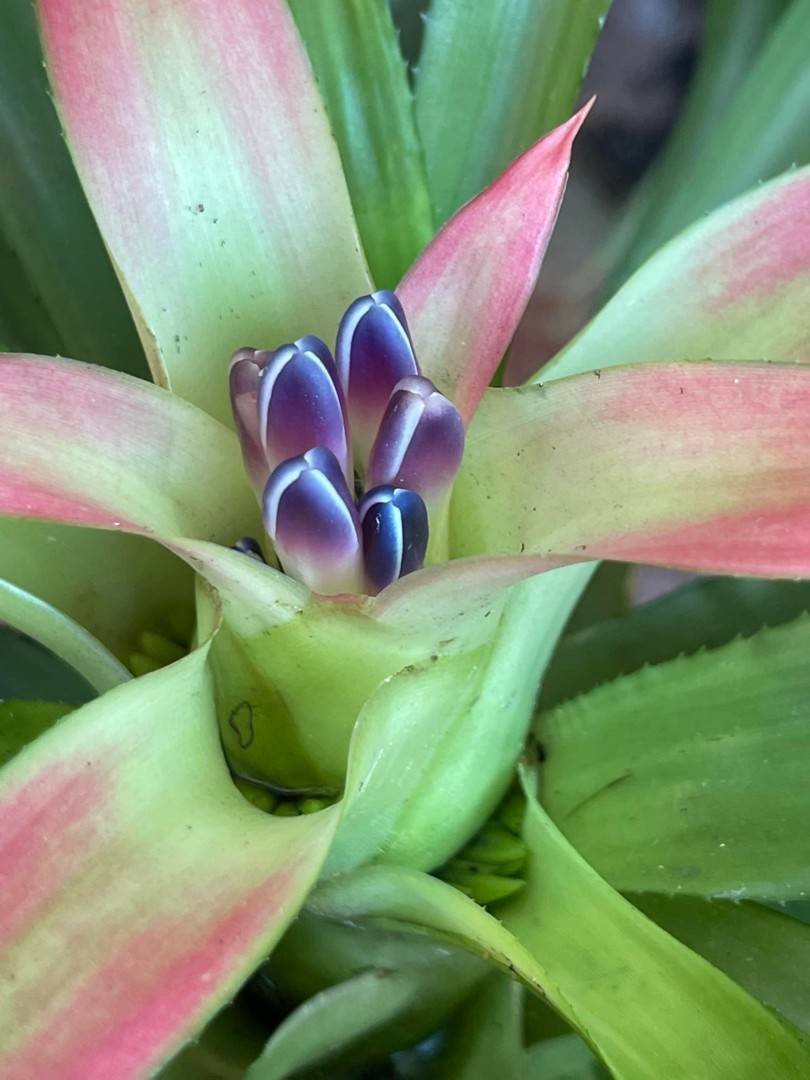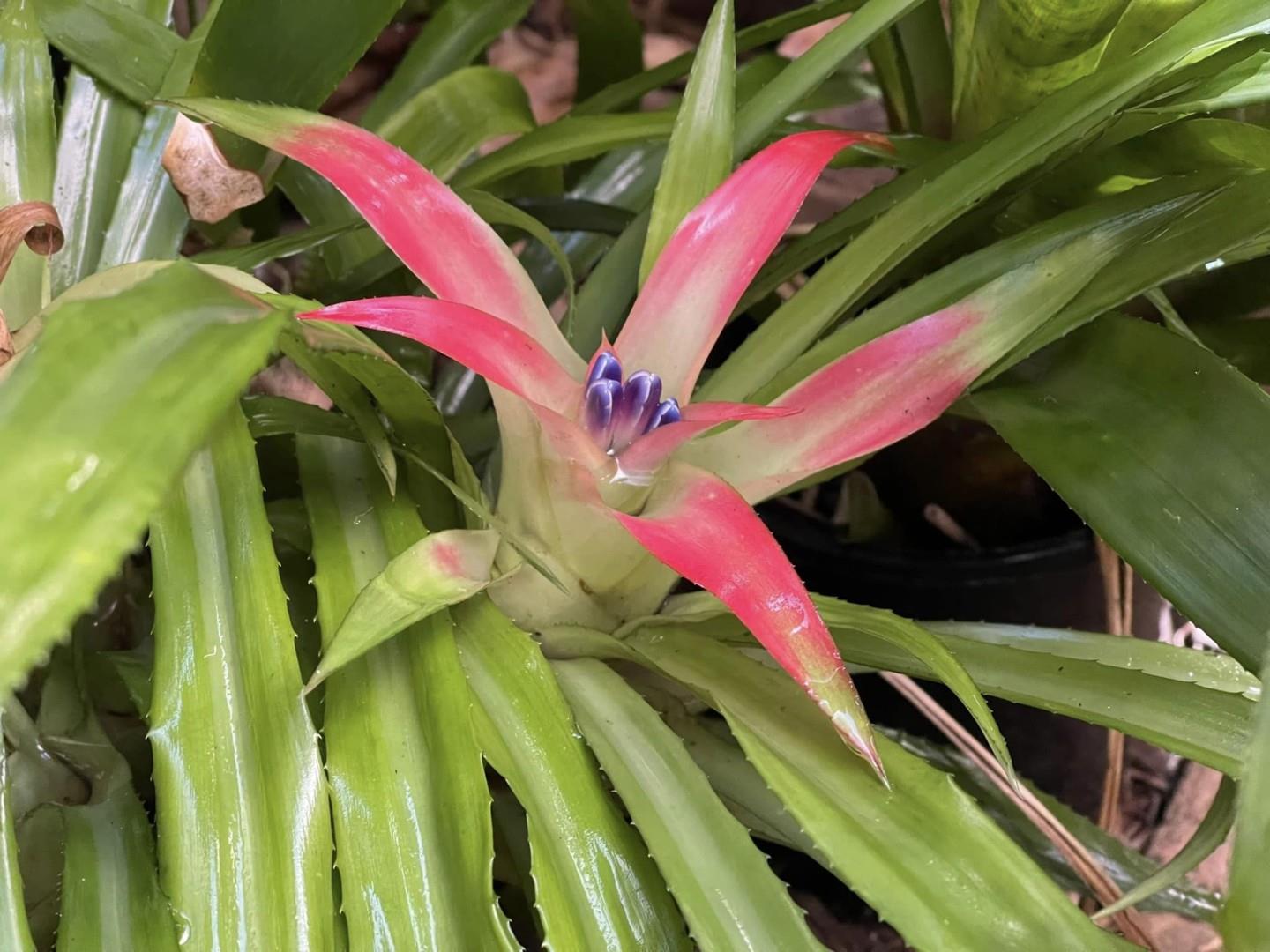




LEAVES 12 to 20, suberect-arcuate, forming a narrow funnelform rosette;
SHEATHS narrowly elliptic to obovate, 8-15 x 4-6 cm, greenish. densely pale-lepidote;
BLADES narrowly sublinear-lanceolate, distinctly narrowed toward base and canaliculate, 25-60 x 1.5-2.5 (-4.5) cm, green, glabrescent, apex acuminate, margins subdensely spinulose, spines ca. 0.5 mm long, 5-10 mm apart.
SCAPE (5-) 7-12 cm long, ca. 0.9 cm in diameter, greenish, distinctly shorter to nearly equaling the leaf sheaths;
SCAPE BRACTS the basal ones subfoliaceous, to exceeding the inflorescence.
INFLORESCENCE bipinnate, obconic, stellate at apex, ca. 7 cm long, 10-15 cm in diameter, exceeding the leaf sheaths but not elevated above the rosette;
PRIMARY BRACTS 10-15 cm long, lepidote toward base, pink to reddish toward apex, with slight distinction between sheath and blade, sheaths broadly elliptic to suborbicular, 5-6 x 5 cm, blades narrowly triangular-lanceolate, acuminate, 5-9 x 2.5-3 cm, suberect to subspreading-recurved, densely spinulose toward the apex, spines ca. 0.5 mm long;
FASCICLES ca. 6, the lower 3-to-4-flowered, 30-35 x 20 mm;
FLORAL BRACTS ovate lanceolate, apex acute and apiculate, entire, 20-25 (-30) x 10-13 mm, sparsely lepidote, greenish toward apex, equaling the middle to the apex of the sepals.
FLOWERS ca. 5 cm long, sessile, slightly fragrant;
SEPALS elliptic to elliptic-ovate, apex acute and minutely apiculate, 14-17 x 5-6 mm, connate for ca 5 mm, glabrous, green;
PETALS ca. 40 mm long, connate for ca. 30 mm, tube white, lobes ca. 10 x 6 mm, blue, bearing 2 inconspicuous callosities at base;
ANTHERS ca. 7 mm long, apex apiculate;
STIGMA ellipsoid to globulose, lobes with crenulate margins;
OVARY subclavate, ca. 10 mm long, 6-7 mm in diameter at apex.
FRUITS white, the persistent calyx green.
TYPE: S. Petersburg Hortus s. n Holotype: LE.
ETYMOLOGY
This species was named in honor of the Russian Counselor von Scheremetiew, whose garden was one of the most beautiful and diversified in Russia, located in Lasarew near Nischi (Reitz, 1983).
DISCUSSION
Nidularium scheremetiewii was described in 1858 by Eduard August von Regel (1786-1845), who, in the same year but in a different publication (Gartenflora), furnished a beautiful colored plate of this taxon. Shortly before this, in 1856, Regel had mistakenly interpreted Caraguata serrata as having the same morphological traits as N. scheremetiewii which altered considerably the original concept of Julius Hermann Schultes. This error was corrected in 1858 when N. scheremetiewii was published as a separate taxon.
The holotype is deposited in the herbarium of the Department of Higher Plants, St. Petersburg Academy of Science (LE), Russia. It is made up of two exsiccata. The first consists of a whole plant with the inflorescence cut in half lengthwise; the second one also consists of a whole plant with an intact inflorescence, plus three separate leaves. Based on this material and the colored plate of this species, it was possible to determine that the original plant is very similar to those of existing populations in the Petropolis-Teresopolis area of the Serra dos Orgaos. These plants are characterized by an ample inflorescence, resting on the leaf rosette, with bright red primary bracts. These populations are slightly different from those of the Nova Friburgo region, whose plants have an inflorescence that is more deeply sunken in the leaf rosette. The populations commonly found in the city of Rio de Janeiro, especially in Tijuca National Park and the surrounding area, are made up of plants that are slightly more delicate than those of the Serra dos Orgaos and Nova Friburgo, often with reddish pink primary bracts. Ule depicted this regional trait in his N. corcovadense, placed in synonymy here, which he informally called "Nidularium graminifolium" on the label of the holotype.
Karatas neglecta is also included here as a synonym of N. scheremetiewii. When K. neglecta was published, Baker (1889) listed as synonyms several names that were available in horticulture such as Nidularium makoyanum and Nidularium neglectum. Mez (1896) stated that N. neglectum, cited by Baker (op. cit.), had originated in Jacob Makoy's garden, and he also correctly excluded N. makoyanum from K. neglecta because the former name had historically been associated with a variety of N. innocentii.
As is clearly stated in the protologue of K. neglecta, Baker based his description on a specimen sent by Edouard Morren from Liege, Belgium, that flowered at Kew in February 1888. This plant is definitely the holotype of the species. Baker also stated that this taxon might be a variety of N. scheremetiewii.
The holotype of K. neglecta was found only recently and I obtained a photograph of it in March 2000. Based on the characteristics provided by the original description and on those that are clearly visible in the photograph of the holotype, I concluded that this taxon does not differ from N. scheremetiewii, as Baker (1889) had suspected. However, Baker (op. cit.) declared that this species had white petals, which is not compatible with petal color in N. scheremetiewii. It seems that Baker wrongfully cited the color shown in a painting by Morren, now deposited in the Royal Botanic Gardens at Kew. Names such as "Karatas", N. makoyanum and Nidularium neglectum are written on the painting, reflecting Morren's view at the time. Today we know that this canvas clearly depicts N. longiflorum whose petal lobes are white. This suggests that Baker may have confused the holotype of his K. neglecta (perhaps he did not see it in flower) with Morren's painting because of the fact that both of these (specimen and painting) came from Morren's botanical collection.
In his description of K. neglecta, Baker (1889) used the abbreviation “M. D” in parentheses, explaining in a footnote: “M. D. means that there is an original drawing of the plant in the Morren collection, now at Kew”. In the preface of this publication, Baker stated that in 1887 the Kew library had received around 250 of Morren's watercolors depicting over 200 species that flowered in cultivation at Liege, Belgium. Most of these paintings also included sketches and notes. This supports the argument that Baker mistakenly used Morren's painting, identified as N. neglectum, thinking that it was his K. neglecta.
Nidularium scheremetiewii is morphologically close to N. utriculosum, N. jonesianum and N. kautskyanum. Distinguishing traits are mentioned in the discussion of each species, to which the reader is referred.
DISTRIBUTION & HABITAT
This species is endemic to the Atlantic slope forest of Rio de Janeiro state. It grows from near sea level on the forested slopes of the city of the same name to altitudes of ca. 1,600 m. in Nova Friburgo. The largest populations of this species are concentrated in Tijuca National Park and Serra dos Orgaos National Park. Although it is common in these areas, it is rather sparsely distributed in the lower forest layers, mainly on the forest floor and on rocks. It flowers from December to March.
Detail from S&D
15. Nidularium neglectum (Baker) Makoy Hortus ex Mez, DC. Monogr. Phan. 9: 99. 1896.
Karatas neglecta Baker, Handb. Bromel. 6. 1889.
Leaves 15-20 in a lax rosette; sheaths large, broadly ovate-elliptic, glabrous beneath, lepidote above with minute strongly appressed dark brown scales; blades recurved, ligulate, acute and then acuminate in a slender apex, narrowed toward base, green, subglabrous, lustrous beneath, laxly serrate with curved antrorse spines 0.5-1 mm long. Scape evident; scape-bracts foliaceous. Inflorescence raised above the rosette; primary bracts 3-5, recurved, red for 3/4 their length. Floral bracts broadly elliptic, apiculate, entire, nearly equaling the sepals; flowers 45 mm long; sepals acuminate, glabrous; petals white.
Type. Described from cultivation, Brazil; no material seen.
Detail from Baker 1889
15. KARATAS NEGLECTA Baker.
Nidularium Makoyanum and neglectum Hort. (M.D.).
Leaves about ten in a long rosette, lanceolate, about a foot long, 1.5 in. broad at the middle, narrowed gradually to the point, moderately firm in texture, bright green above, paler green beneath, without any spots or bands, the marginal teeth very inconspicuous. Flowers in a small capitulum in the centre of a few reduced brownish-green inner leaves. Corolla white.
Hab. Probably Brazil. Described from a plant that flowered at Kew, Feb. 1888, received from Prof. Morren. May be a variety of N. Scheremetiewii.
16. KARATAS SCHEREMETIEWII Antoine, Brom. 46, t. 27.
Nidularium Scheremetiewii Regel, Gartenfl. t. 224; Rev. Hort. 1875, 230, with figure (M.D.). Caraguata serrata. Hort.
Leaves 10-15 in a short rosette, lanceolate, 1-1.5 ft. long, an inch broad at the middle, narrowed towards the base and gradually to the point, moderately firm in texture, bright green on the face, pale green on the back, sharply serrated. Flowers in a small capitulum in the centre of the bright scarlet reduced sharply-toothed inner leaves; flower bracts lanceolate, falling short of the calyx. Ovary white, 0.5 in. long; sepals lanceolate, greenish, 0.75 in. long. Petals violet, protruded 0.5 in. beyond the tip of the calyx. Filaments very short.
Hab. South Brazil, Glaziou 15849 ! Introduced to the St. Petersburg Botanic Garden in 1858. Described from plants that flowered at Kew in 1877 and 1885.